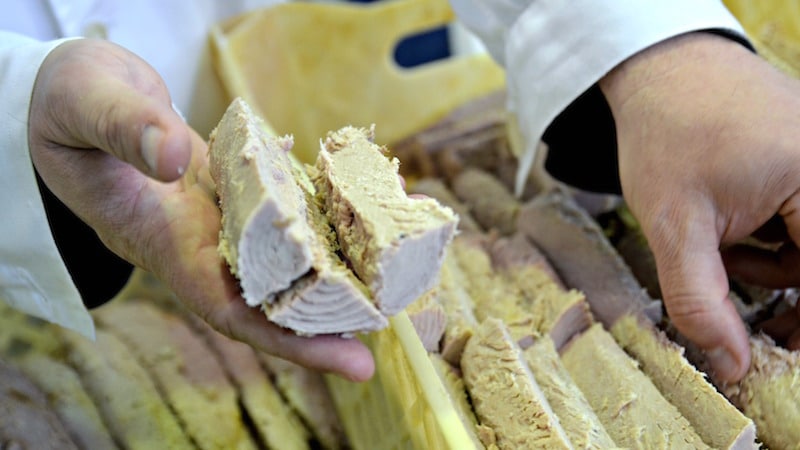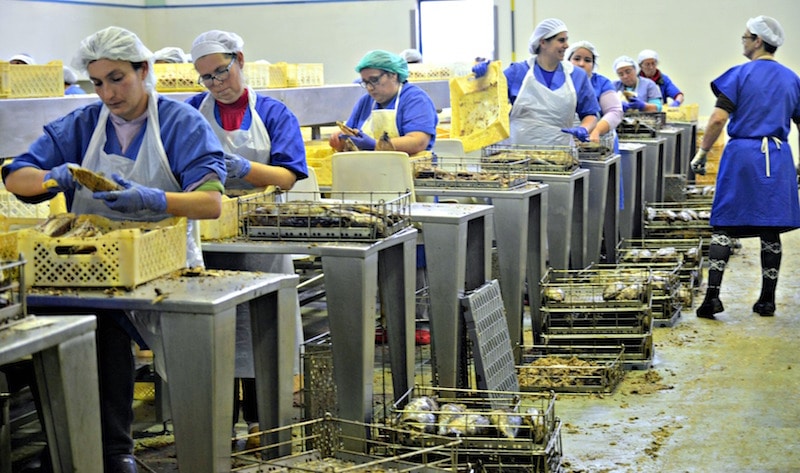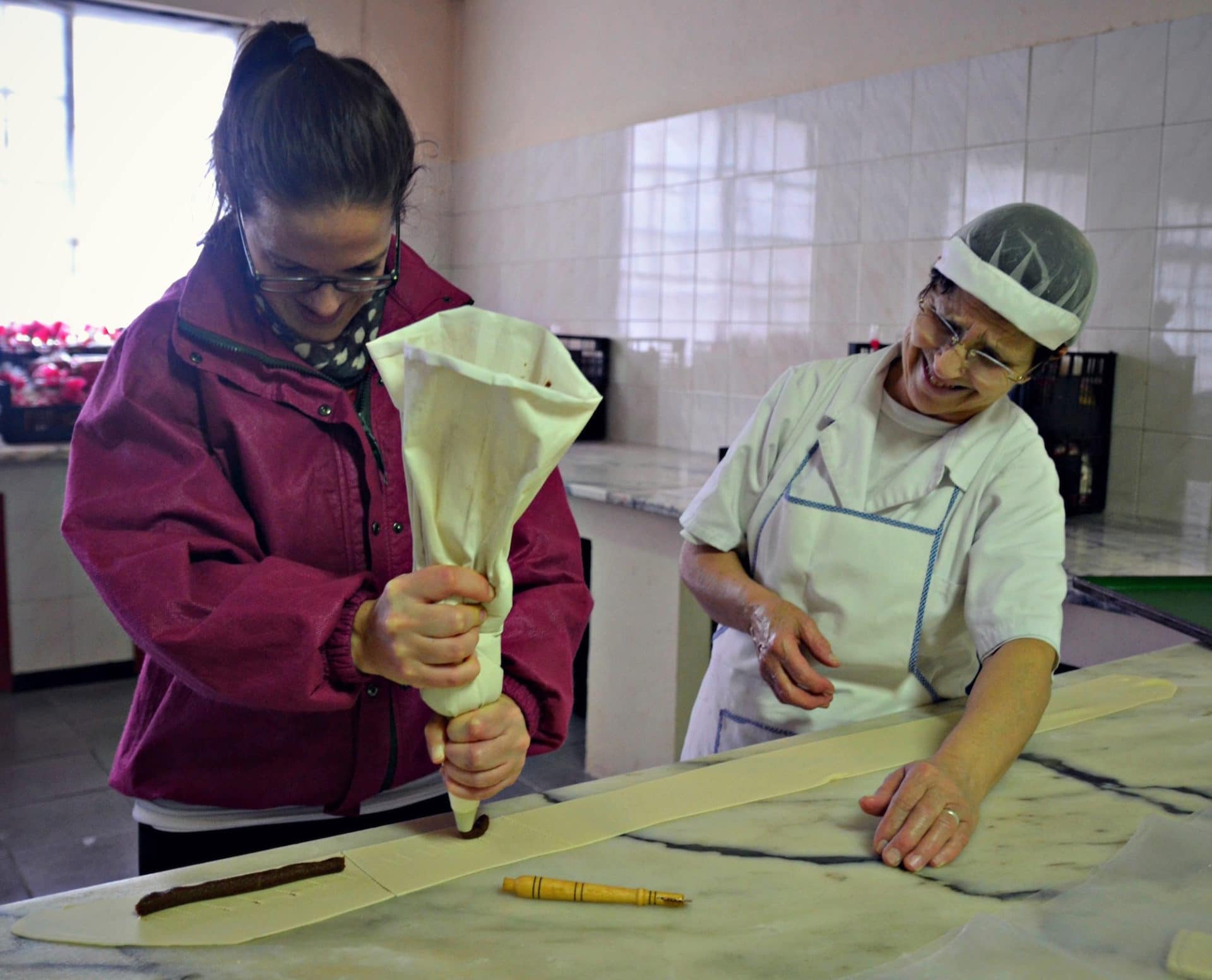Azores Travel: Exploring Adventure & Artisan Culture On São Jorge Island
It takes me a bit to get used to the hairpin turns, the almost Mario Kart-like feeling of zooming right into basalt rock walls or toppling down cliffside.
Luckily, the idyllic scenery of São Jorge, a mix of water, mountains and country, helps relax me; and once I do, I really enjoy my foreign surroundings.
It’s not just the driving that’s different from my home of NYC — where you’re actually much more likely to crash, trust me, I’ve done it — but the entire personality of the destination.
São Jorge is a quiet island, formed into a long and narrow shape from past volcanic eruptions. A dinosaur-like mountain range back-bone features numerous worthwhile viewpoints, while the more than 70 fajãs — flattened areas near the sea created by lava flows and detached land and rocks from earthquakes that are hugged by cliffs — offer a look into a more traditional and isolated way of life.
No matter where you are, you’ll have the Atlantic Ocean on one side and fields of green dotted with grazing cows, emerald peaks, yellow azeda flowers and stone homes on your other. It’s the type of place where neighbors don’t think twice about helping neighbors, locals use natural resources because it’s logical instead of because it’s cool, and mass tourism has not yet ruined the pristine natural beauty and culture of the island.
Part of the Azores’ central group of islands, São Jorge features 95 square miles (246 square kilometers), with the main municipalities being Velas and Calheta.
For such a small island there’s an amazing amount of diversity in terms of things to do and see whether you’re traveling in a group or enjoying solo travel in Portugal.
You can go dolphin and whale watching (20 different whale species), bird watching (about 25 permanent resident species plus migrating birds), hiking (7 official trails and even more unofficial trails), visit churches and museums, and tour artisanal factories to get to know the local products.
Artisanal Sao Jorge
Protected Cheese
This is exactly what I do on my first day, beginning with the famous São Jorge cheese — renowned all over The Azores — at Uniqueijo cooperative in Beira, where they produce protected designation of origin (PDO)-classified raw milk cheese.
Eat at almost any local restaurant, and you’ll have it served as a complimentary of budget-friendly starter with bread and jam (hear that, New York?).
After dressing up in a plastic gown, hat and booties, I’m taken on a guided tour of the plant, viewing how the cheese begins as raw milk and moves through the different phases to become a perfectly firm wheel-shaped cheese, an important aspect of attaining the PDO São Jorge Cheese label.
There will also be a colored stamp to tell you the cheese’s age: black/7 months, red/4 months or green/3 months.
The stinky experience continues into a bar and shop, where I peruse local dairy products and homemade pastries, and also savor a comparative tasting of a young 3-month aged cheese, which has a yellower color and more soft and salty flavor, and a 7-month aged cheese, which is slightly firmer, sharper and even a bit spicy.
My guide informs me that many guests inquire if they add pepper to their older cheeses, when in fact the taste occurs naturally, especially in the Sao Jorge Cheese.
Sustainable Tuna
Nearby, I’m introduced to another artisanal food production space at Santa Catarina, located right on the Atlantic Ocean.
The operation is more than just a sustainable tuna factory; it’s a social project producing over 100 jobs for local women.
They offer tours of the factory, where you’ll see workers hand-canning local Skipjack Tuna — all caught individually with a pole and hook — and adding ingredients like ecological olive oil, thyme, oregano and sweet potato to appeal to a variety of tastes.
I’m amazed as I wander the space, a sea of females literally hand-cleaning, hand-cutting and hand-canning the fish or cutting it into filets.
They do have some machine-canned items sold at a lower price point, and even these are a wonder to watch as the tins come down from the ceiling via conveyor belt.
It’s interesting to see the care and precision that went into the product, the meat uber fresh and so different from what I’m used to back home.
I also love the commitment to sustainability, certifications like Dolphin Sea, Friend of the Sea and Qualidade Azores proudly displayed on the wall.
Local Sweets
I like to finish off a savory experience with something sweet, and a visit to Dulcores allows me to taste a number of traditional sweets, all hand-made and baked in a wood burning oven. One of the most popular is espécie, named after the numerous spices — especially anise — that burst out of the circular cookies crust slits.
As I’ve told the owners beforehand I wanted to come to take photos for a story, they took me back into their kitchen and let me make my own espécie cookies, first rolling the dough, then cutting seven small slits before squeezing out a line of spice mix over the holes.
Next, I roll the dough and make extra holes, closing the edges my pressing and closing the two snake-like ends together. It’s fun, but I’m pretty sure they won’t be hiring me anytime soon, judging by my deformed (but still edible!) cookie.
They show me a number of other local specialties, as well.
For something booze infused and not sweet, the roquilhas de aguardente consists of aguardente (aka “fire water,” alcoholic drinks with between 29% and 60% alcohol by volume), eggs and flour made into a round shape that’s boiled then put into the oven, slits cut into the crust and re-baked so it puffs out into a flower.
Suspiros is a delicious lemon-laced merengue puff, while esquecidas — which means “forgotten” — is an uber sweet cookie you’ll forget to stop eating they’re so tasty.
The Azores us a very religious destination, mainly Catholic, and a loaf of pancake-like Bolo de Vespera — reminiscent of the Body of Christ — featuring Festa do Divino Espírito Santo (Holy Ghost Festival) stamps is a great way to explore this through the palate.
Women-Made Handicrafts
For those who want to support local women, immerse themselves in local culture and grab an authentic souvenir, Cooperativa de Artesanato Senhora de Encarnacao in Urzelina in the Ribeira do Nabo on Sao Jorge is a must.
Here you’ll find the work of five local women who create woven items, local basalt carvings, jewelry and embroidery often crafted from recycled materials.
Some cool finds: bottle bibs featuring local themes like cheese and marine creatures; multi-colored placemats crafted from recycled cloth cut into threads and woven together; bedspreads dyed brown with onion skins and nuts; and special renda chilena lace that looks like fishing net and is found only on Sao Jorge.
The cooperative is open 9-6 during the week and Saturdays in summer, although Zelina lives next door and if you give her a call she’s happy to run over and let you in.
Clearly, artisan experiences abound on São Jorge; however, that’s not the only reason to explore Sao Jorge. Another: nature.
Natural São Jorge
I take in some my best views by driving along the island’s south coast.
Traveling down the main road from Velas to Topo — at the very tip of the eastern end of the island, where the Finisterra cheese cooperative is — I make a stop in Cruzal.
I’m instructed by the tourism board that when I come to a creek and small bridge with a Holy Cross on one side, I’ll find a small and beautiful walking path on the opposite.
I do, and it only takes about 10 minutes of downhill hiking before I come to a waterfall, its gushing cascades like a forest secret, as nobody else is there aside for me, maybe because no signs on the road tell people how to get here. Basically, the perfect way to experience nature.
The Ilheu do Topo viewpoint — within a Partial Nature Reserve — is also magnificent, and you can see Terceira as well as a small deserted island with nothing but cows, who are brought there to graze by local farmers.
A short walking path beside the viewpoint takes me down to the water, and to a camping area and man-made pool in the ocean.
As I’m visiting in winter I don’t dare go in the chilly waters, but I imagine in summer it’s full of sunbathers and swimmers enjoying the paradise setting.
Driving on less than 10 minutes more, the fishing port offers a dramatic visual experience, although you’ll need to be willing to park at the top of a sharp incline and walk down and back up, or risk your vehicle getting stuck.
It’s a nice stop paired with the actual area of Topo, the most rural area of the island featuring colorful traditional rock buildings and the giant Nossa Señora da Conceicao church, one of the most important places on Sao Jorge during the annual Espírito Santo, an important community festival focused on sharing on the first Sunday after Easter that lasts for eight Sundays.
The stretch driving back from Topo to Velas is magnificent — by far my favorite of São Jorge — the top of the active Mount Pico stratovolcano, the highest mountain in Portugal at 2,351 meters (7,713 feet), sprouting above the cloud line, forming a breathtaking background to the sloping green landscape pushing white and brown trim homes to the Atlantic, cows munching on emerald green grass, somehow without tumbling down into the water.
Exploring São Jorge’s North Coast
While all of my experiences thus far have been on São Jorge’s south coast, I opt to spend a day exploring the north side, the less populated, more mountainous stretch.
The ocean is still there, although my constant views of Pico have been replaced by Graciosa and Terceira, other neighboring Azores islands. Stone walls are now endless natural barriers of blue and white hydrangeas.
The route is Velas to Fajã dos Cubres, as I’ll be hiking from here to Fajã da Caldeira de Santo Cristo, the place where they catch São Jorge’s famous clams.
To get psyched, I stop at the Fajã dos Cubres viewpoint along the way, unmissable jutting off a wide turn in the road as you wind down the mountain on narrow roadway.
The aerial vista makes São Jorge look even more alive than it already is, with mountainous bodies and island toes stretching into the ocean, natural pools shimmering like jewelry.
In Fajã dos Cubres it’s immediately clear people in the fajã live differently than those higher in the mountains, low rock walls guarding small stone houses, clothes lines billowing the very artisan weavings I’d seen yesterday at the handicraft shop.
I park right in front of the ocean, breathing in the fresh air as I step out. The path I’m doing is 4 kilometers (2.5 miles) each way — although you can also extend it to 10 kilometers (6.5 miles) each way if you have the time and go to “Serra do Topo” in the mountains, where I’ve been told there’s also a waterfall.
The path I do begins with an uphill climb through native vegetation, the incline switching from down to up, up to down, until the trees clear and I appear on the cliff side, crashing waves and rock to my left and the mountainside to my right.
After awhile, I find myself strolling through Fajã da Caldeira de Santo Cristo, the traditional stone architecture offering a nostalgic feel. In the summertime, some of these locals offer their homes up as bars and restaurants, something I’d highly recommend stopping for.
Finally, I emerge out from winding path flanked with houses, my destination straight ahead: a naturally separated lagoon within the ocean where São Jorge’s famous clams are caught, created by an earthquake in 1757.
Interestingly, you won’t find clams anywhere else in the Azores — not even one foot away in the open Atlantic — only in this accidental pool. I see the flippers of a diver heading down for the shellfish, which only certified people can collect as the clams are protected.
Today, it remains a mystery how the clams got there, and why they reproduce so easily in this particular place.
All this clamming has me craving the local dish, and I head to what has easily become my favorite restaurant on São Jorge: Cairneros.
You’ll need to call ahead if you want something more than a burger or snack, but trust me, the planning is worth it.
While each restaurant has their own recipe for their clams, here they make them spicy with red pepper, just the way I like my food and drink.
Despite the added heat, I’m able to taste my destination through the sea flavors, appreciate the island through the palate.
I enhance the experience by savoring their “Torremos de Porco” — pork marinated in red wine, salt, garlic and spices and then fried in pork fat — and the “Polvo Assado,” a hearty octopus casserole with massive chunks of seafood and potatoes.
Sitting at the table I savor my food, discovering local flavors and ecosystems through the palate. I have nowhere to be. Unlike in NYC, where lunch is typically a sandwich shoved in my mouth and eaten in three bites, I fall right into the serene and slow-paced vibe of São Jorge.
I can’t stay here forever, but for now, I let it consume me. Because, this is what travel is all about.
If visiting Portugal, you certainly won’t want to miss the Azores.
General Information:
*Car rentals (recommended for exploring the island) and tourist information are available in the airport when you get off your flight. Otherwise, you can inquire with the tourism board about local drivers and English-speaking guides (you will want this if you’re going to a lot of the smaller cooperatives and artisan production spaces).
*It’s recommended to make a stop at the local tourism board office — either in the airport or at R. Conselheiro Dr. Jose Pereira 9800 in Velas (+351 295 412440) — for maps and the most up-to-date suggestions.
*One of the best reasons to visit São Jorge is its proximity to Pico, Terceira and Faial Islands, meaning you can take a budget-friendly boat ride to neighboring Azorean destinations instead of opting for the more expensive flight. Check AtlanticOnline for deals and passes.
Attraction Information
*Uniqueijo, Beira 9800-501 Velas São Jorge; +351 295 438 274/5; [email protected]
*Finisterra, Santo Antão, 9875 – 039 Topo São Jorge; +351 295 415 216; [email protected]
*Santa Catarina – Indústria Conserveira, S.A. Rua do Roque, 9 | 9850 – 079 Calheta Ilha de São Jorge; +351 295 416 220; [email protected]. Soon, they’ll be offering tours that will also offer a tasting and wine pairing for a more encompassing view of the local food culture.
*Dulcore, Canada Dos Vales, Ribeira Seca, Ilha De São Jorge; +351 295 416 904
Carneiro, Estrada Regional, Biscoitos, São Jorge; +351 911 938 220*Cooperativa de Artesanato Senhora de Encarnacao, Ribeira do Nabo, 9800 – 403 São Jorge; +351 295 414 296
*My trip to the Azores was sponsored by the Azores Tourism Board. I was not required to write this post nor was I compensated for it. All opinions are my own, and all stories are based on my unique experiences exploring the destination.


Hi, I’m Jessie on a journey!
I'm a conscious solo traveler on a mission to take you beyond the guidebook to inspire you to live your best life through travel. Come join me!

Want to live your best life through travel?
Subscribe for FREE access to my library of fun blogging worksheets and learn how to get paid to travel more!

























Hi Jessie,
Thank you for this very informative article. Two of my daughters, a son-in-law, my sister and her husband and I will be visiting Sao Jorge next month. I was born on this island 64 years ago and left when I was 4 years old. This will be my first time back. There are so many things I want to see on this beautiful island. We are very interested in the Cruzal waterfall. It sounds fascinating. Would it be possible for you to provide me with more specific detail on how to find it? It sounds like it might be tricky finding it. Any help you could give me with this would be greatly appreciated. Thank You!